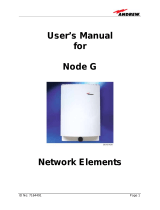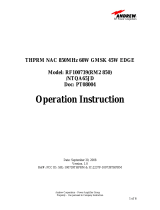
Andrew Corporation
Proprietary – Use pursuant to Company Instruction
1 of 8
1960 CDMA Multiple Carrier Power Amplifier
Model: RF100978
Operation Instruction
Date: Mar 19, 2008
Version. 1.1
Ref# FCC ID S8L-100978MCPA

Andrew Corporation
Proprietary – Use pursuant to Company Instruction
2 of 8
Introduction
This document presents description of the Andrew Corporation 1960 CDMA Band MCPA
(Multi-Carrier Power Amplifier) amplifier. The MCPA amplifier is a high power, RF
amplifier intended to provide signal amplification and conditioning. The MCPA
amplifier is compatible with CDMA air interfaces operating in U.S. domestic cell sites
where FCC compliance is mandatory.
The 1960 CDMA band (1930 MHz to 1990 MHz) RF power amplifier is capable of
amplifying multiple carriers to a composite power level of 75 Watts.
MCPA Specifications
The RF100978 provides linear amplification of multi-carrier signals in the CDMA
frequency band. The specifications are:
Parameter Specification
Operating RF Band 1930MHz – 1990MHz
Instantaneous BW 15MHz
Input DC Power +24 VDC, nominal
DC voltage input range +18VDC to +30VDC
Rated Output Power
@ ≥ 18 to 30 VDC input
75W composite average
Rated Power per Carrier 37.5W (2 carriers) 25W (3 carriers)
DC-RF Efficiency
>27%, rated output power, nominal
input voltage @ 25°C
Input signal type CDMA (IS-95)
Physical dimensions 16.1” (H) x 3.54” (W) x 15.7”(D)
Weight 35lbs
Cooling technique External fan tray or shelf
Temperature Range -5°C to +55°C operational
Table 1 MCPA Specifications

Andrew Corporation
Proprietary – Use pursuant to Company Instruction
3 of 8
The amplifier has been designed to support an instantaneous bandwidth of 15 MHz.
Multiple carriers may be placed within a continuous 15 MHz span in the CDMA band
and the product shall meet specified performance marks.
The amplifier has a nominal gain of 47.5 dB. The MCPA is designed to meet IS-95
specifications over frequency, temperature (-5°C to +55°C), and power level (up to a
maximum of 75W RF output power).
Functional Blocks:
The 1960 CDMA MCPA is comprised of the following functional areas:
- Predistortion Circuit
- Main amplifier Stage
- Power conversion and conditioning circuit
- Controller circuit
- Communications circuit
Inputs and Outputs:
The amplifier is powered from a DC supply voltage which can range from +18V to
+30V. The DC power is brought into the amplifier through a D-Sub connector located on
the front faceplate of the amplifier.
A second D-Sub connector located on the amplifier front faceplate is used for RS-485
communication. This connector is used for amplifier configuration, monitoring and
alarms.
Alarms and operating state are communicated to the outside world through the RS-485
communications bus and a visible bi-color LED located on the amplifier front faceplate.
The RF signal is brought into the amplifier through one SMA type connector located on
the front faceplate of the amplifier. The amplifier RF signal is brought out of the
amplifier through a N type connector located on front faceplate of the amplifier
Control System:
A microprocessor controller is used to control the amplifier alarm system, control
environmental compensation of the amplifier, and to maintain a linearization solution for
the predistortion circuit.

Andrew Corporation
Proprietary – Use pursuant to Company Instruction
4 of 8
Figure 1
RF100978 MCPA Front Panel Figure 2 RF100978 MCPA Back Panel
Figure 3
RF100978 MCPA Top & Bottom Panels

Andrew Corporation
Proprietary – Use pursuant to Company Instruction
5 of 8
Figure 4
RF100978 MCPA Side Panels

Andrew Corporation
Proprietary – Use pursuant to Company Instruction
6 of 8
The following table is a summary of detailed alarms within the MCPA. The alarms are
mapped to front panel LED behavior, as indicated. Additionally, the alarms are available
at the D-Sub connector at on the front faceplate of the MCPA.
Condition
Alarm
Type
Description LED
Color
Initial Power
On, no
alarms
- - Red
Gain Control Minor Automatic Gain Control
Loop out of specification
Green
Linearization Minor Output Inter-modulation
Products are out of
specification
Green
High
Temperature
Warning
Minor High Temperature Warning Green
DC voltage
regulation
Minor DC Voltage regulation out
of range Warning
Green
High DC
power
consumption
Minor High DC Power
Consumption Warning
Green
Partial Main
Amp Failure
Minor Partial failure within RF
chain, RF output is backed
off
Green
Temperature
Overload
Major Overload Temperature
threshold reached. Unit will
shutdown
Red
DC/DC
converter
Shutdown
Major Failure within DC/DC
converter. Unit will
shutdown
Red
DC Power
Consumption
Overload
Major Overload DC Power
Consumption. Unit will
shutdown
Red
Table 2 Alarm mapping for MCPA
Note 1: During a Minor Alarm event, RF output is enabled, however, the product may be
out of specification. Minor Alarms are recoverable.
Note 2: During a Major Alarm event, the unit will shutdown for self-protection. Major
Alarms are non-recoverable and require a Reset or cycling of the power switch
Note 3: Details as to the specific alarm event are retrieved through the front panel RS-
485 interface.

Andrew Corporation
Proprietary – Use pursuant to Company Instruction
7 of 8
The following table shows the pin out for the D-sub connector including the alarm pins.
Signal Description Pin Number
Manual Control Control ON/OFF 1
GND Ground 2
PA-Enable-Actif + Control 3
PA-Enable-Actif - Control 4
PA_Presence_Reset Towards Micro Controller 5
GND_Presence_Reset Ground 6
Reserved Not allowed for the MCPA 7
GND Ground 8
Reserved Not allowed for the MCPA 9
Reserved Not allowed for the MCPA 10
GND Ground 11
Reserved Not allowed for the MCPA 12
Red LED LED 13
UART TX + (TRM to
MCPA)
Exchanged Information 14
UART TX - (TRM to
MCPA)
Exchanged Information 15
Reserved Not allowed for the MCPA 16
UART RX + (MCPA to
TRM)
Exchanged Information 17
UART RX - (MCPA to
TRM)
Exchanged Information 18
GND Ground 19-24
Green LED LED 25
Table 3: Pin out for D-Sub connector

Andrew Corporation
Proprietary – Use pursuant to Company Instruction
8 of 8
Installation and Operation Set-Up
The MCPA must be installed into a shelf that provides fan-cooling. The MCPA requires
+24VDC with a current handling capacity of up to 12.4A. An RS-485 interface is
provided and must be utilized to configure the PA for operation and monitoring of alarms
and status. RF cables connect from a radio source to the SMA-type input; from the N-
type output to a filter-duplexer module.
FCC Statements:
FCC ID S8L-100978MCPA
This device complies with Part 2, 15 & 24 of the FCC Rules. Operation is subject to the
following two conditions: (1) this device may not cause harmful interference and (2) this
device must accept any interference received, including interference that may cause
undesired operation.
Warning
Changes of modifications not expressly approved by the manufacturer could void the
user’s authority to operate the equipment.
-
 1
1
-
 2
2
-
 3
3
-
 4
4
-
 5
5
-
 6
6
-
 7
7
-
 8
8
Andrew Corporation RF100978 User manual
- Type
- User manual
- This manual is also suitable for
Ask a question and I''ll find the answer in the document
Finding information in a document is now easier with AI
Related papers
Other documents
-
Andrew Wireless System Node C User manual
-
Ericsson 1/KRB 101 1108 Installation, Operation And Maintenance Instructions
-
 Andrew Node G 930 User manual
Andrew Node G 930 User manual
-
ADC Digivance NXD Installation and Maintenance Manual
-
COBHAM BSF0060 User Handbook Manual
-
Siemens SINUMERIK 802D sl Training manual
-
Bunn MCA Installation guide
-
Bunn MCA User guide
-
ADC Network Router NXD User manual
-
Bunn MCPA Datasheet










